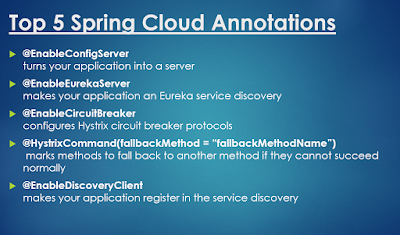5 Spring Cloud Annotations Java Programmers Should Know
New to Spring Cloud? Here are the top five annotations that you must know.
Join the DZone community and get the full member experience.
Join For FreeIf you are developing a Java application for Cloud, then you should learn Spring Cloud; this is a great framework and extension of the popular Spring Framework, which can help you to develop a cloud-native Java application. Spring Cloud provides several necessary services required for a cloud-based Java application, like configuration management, service discovery, circuit breakers, intelligent routing, micro-proxy, a control bus, one-time tokens, global locks, leadership election, distributed sessions, cluster state, etc.
On top of that, it builds on the Spring Framework, so it automatically provides the essential features like dependency injection and inversion of control, which results in loosely coupled and easy-to-test Java applications.
Since the cloud is the future and, in the coming days, we will see a lot of Java applications deployed on the cloud like AWS, it's better to learn and master Spring Cloud, which might become the standard framework to develop cloud-based Java applications in the future.
If you are looking to learn a new Java framework in 2019, you can start exploring Spring Cloud. It would be a great addition to your portfolio.
If you have already decided to learn Spring Cloud in 2019, then I strongly suggest you check out Josh Long's Cloud-Native Java, one of the most awesome books about learning cloud-based Java development. It will teach you Spring Boot, Spring Cloud, and also other essential, cloud-based concepts you should know.
And if you prefer online courses more than books, then you can also checkout Microservices With Spring Cloud on Udemy. This is one of my favorite courses on Spring Cloud, and if you need more choices, you can also take a look at this list of some of the best Spring Cloud courses for Java developers.
5 Spring Cloud Annotations Java Developers Should Know
Anyway, in this article, we'll take a look at some of the key Spring Cloud annotations you will see while developing cloud-based Java applications using the Spring Framework.
Since Spring uses annotations to provide functionality, instead of asking you to implement a particular interface from the framework, it will give you a decent idea of how Spring Cloud can help you develop cloud-native Java applications.
Also, if you are new to the Spring Framework, I suggest spending some time learning the core framework and its features. If you need a course, Spring Framework Master Class - Beginner to Expert is a great one to start with.
Anyway, let's see some of the essential Spring Cloud annotations you need to know to get started:
1. @EnableConfigServer
This Spring Cloud annotation turns your application into a server, which other applications can use to get their configuration. This is a very useful annotation for developing microservices in Java using Spring Cloud, where you can afford to have one dedicated Java service for Configuration.
2. @EnableEurekaServer
This Spring Boot annotation makes your application a Eureka discovery service, which other applications can use to locate services through it. This is again an important step in developing microservices in Java using Spring Cloud.
3. @EnableDiscoveryClient
This Spring Cloud annotation makes your application register in the service discovery and discovers other services through it.
Also, if you are thinking about moving your existing Java application to the cloud, you should check out this Spring Cloud Fundamentals course on Pluralsight by Dustin Schultz. This course explains how Spring Cloud helps you migrate your existing Java application to the cloud and develop Java applications for the cloud from scratch.
However, you would need a Pluralsight membership to get access to this course, which costs around $29 per month or $299 annually (14 percent discount). They also provide a 10-day free trial without any commitment, which is a great way to not just access this course for free but also to check the quality of courses before joining Pluralsight.
4. @EnableCircuitBreaker
This Spring Cloud annotation configures Hystrix circuit breaker protocols.
If you have to build a microservice application that uses the Circuit Breaker pattern, then you know that it can gracefully degrade functionality when a method call fails.
Use of the Circuit Breaker pattern also allows a microservice to continue operating when a related service fails, preventing the cascading failure and, thus, giving the failing service time to recover.
5. @HystrixCommand(fallbackMethod = “fallbackMethodName”)
This Spring Boot annotation marks methods to fall back to another method if they cannot succeed normally.
If you know, Netflix’s Hystrix library provides an implementation of the Circuit Breaker pattern, and the Spring Cloud Netflix Hystrix looks for any method annotated with the @HystrixCommand annotation and wraps that method in a proxy connected to a circuit breaker so that Hystrix can monitor it to handle failures. See Java Microservices with Spring Cloud to learn more.
Currently, this works only on classes marked with the @Component or @Service annotations.
Here is a nice summary of all these essential Spring Cloud annotations for quick reference:
That's all about some of the useful Spring Cloud annotations for developing cloud-based Java applications. Since the cloud is the future and the adoption of cloud-based applications is growing, I strongly suggest Java developers explore Spring Cloud, and there is no better way to start than reading Cloud-Native Java. If you haven't read it already, add this book into your reading list to stay ahead of your competition.
Further Learning
Thanks for reading this article so far. If you like these Spring framework annotations, then please share with your friends and colleagues. If you have any questions or feedback, then please leave a comment below.
Published at DZone with permission of Javin Paul, DZone MVB. See the original article here.
Opinions expressed by DZone contributors are their own.


Comments